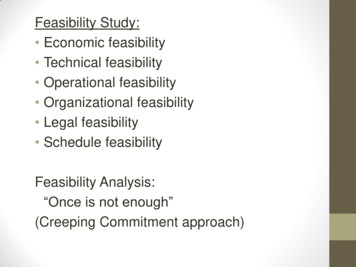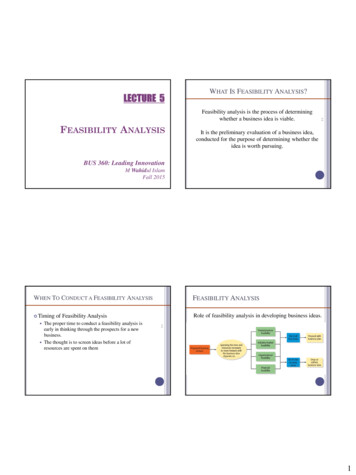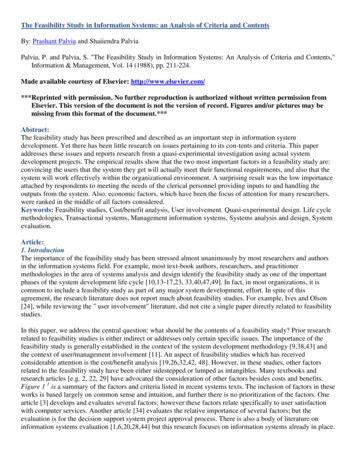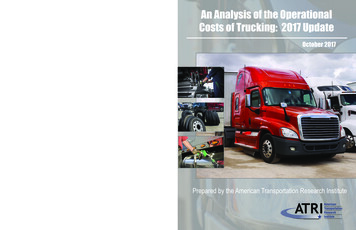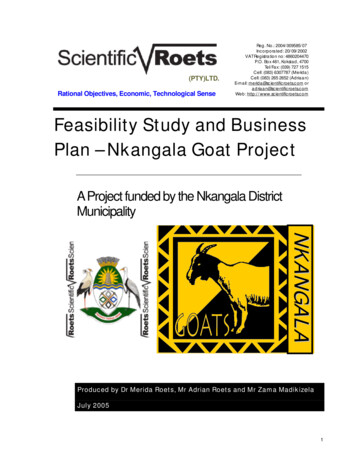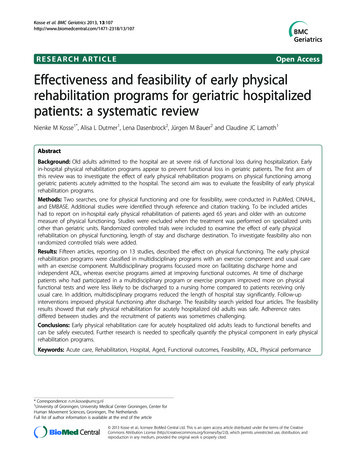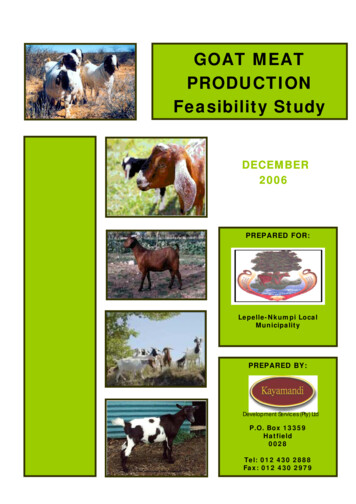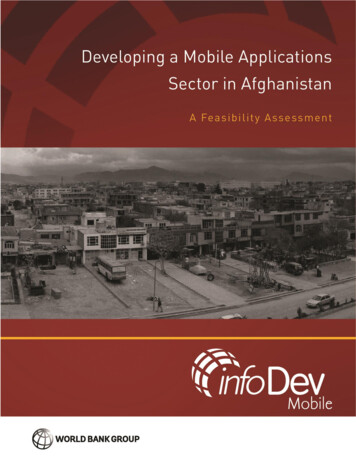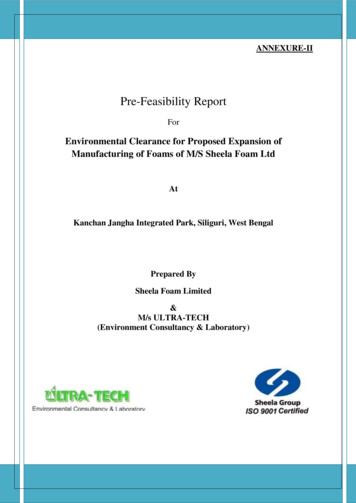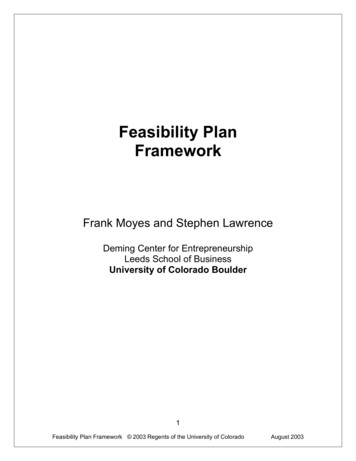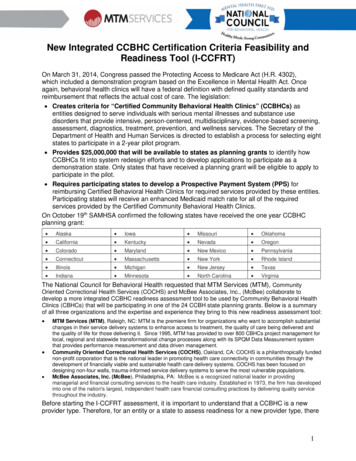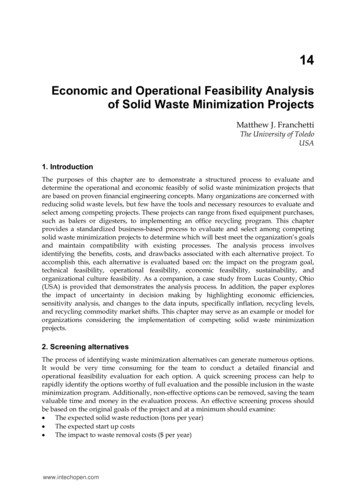
Transcription
14Economic and Operational Feasibility Analysisof Solid Waste Minimization ProjectsMatthew J. FranchettiThe University of ToledoUSA1. IntroductionThe purposes of this chapter are to demonstrate a structured process to evaluate anddetermine the operational and economic feasibly of solid waste minimization projects thatare based on proven financial engineering concepts. Many organizations are concerned withreducing solid waste levels, but few have the tools and necessary resources to evaluate andselect among competing projects. These projects can range from fixed equipment purchases,such as balers or digesters, to implementing an office recycling program. This chapterprovides a standardized business-based process to evaluate and select among competingsolid waste minimization projects to determine which will best meet the organization’s goalsand maintain compatibility with existing processes. The analysis process involvesidentifying the benefits, costs, and drawbacks associated with each alternative project. Toaccomplish this, each alternative is evaluated based on: the impact on the program goal,technical feasibility, operational feasibility, economic feasibility, sustainability, andorganizational culture feasibility. As a companion, a case study from Lucas County, Ohio(USA) is provided that demonstrates the analysis process. In addition, the paper exploresthe impact of uncertainty in decision making by highlighting economic efficiencies,sensitivity analysis, and changes to the data inputs, specifically inflation, recycling levels,and recycling commodity market shifts. This chapter may serve as an example or model fororganizations considering the implementation of competing solid waste minimizationprojects.2. Screening alternativesThe process of identifying waste minimization alternatives can generate numerous options.It would be very time consuming for the team to conduct a detailed financial andoperational feasibility evaluation for each option. A quick screening process can help torapidly identify the options worthy of full evaluation and the possible inclusion in the wasteminimization program. Additionally, non-effective options can be removed, saving the teamvaluable time and money in the evaluation process. An effective screening process shouldbe based on the original goals of the project and at a minimum should examine: The expected solid waste reduction (tons per year) The expected start up costs The impact to waste removal costs ( per year)www.intechopen.com
266Integrated Waste Management – Volume I The impact to purchasing costs ( per year) The impact on employee moral The ease of implementationThe team should keep in mind that the goal of the screening the process is to quicklyidentify options worthy of further analysis. A weighted scoring system should be developedand applied to rank each alternative in an objective manner. A Quality DeploymentFunction, such as the ‘House of Quality’ is an excellent tool to accomplish this evaluation. AHouse of Quality is a graphic tool for defining the relationship between the organizationneeds and the capabilities. It utilizes a planning matrix to relate the organizational wants(for example solid waste reduction and cost performance) to how the waste minimizationprogram will or can meet those wants (for example process changes or recycling efforts). Itlooks like a house with a correlation matrix as its roof and the organizational wants versuswaste minimization options as the house structure. Another benefit of the House of Qualityis that is may increase cross functional integration within the organizations using it,especially between marketing, engineering, and manufacturing.Before proceeding with the screening process, the team should decide on the evaluationcriteria (the “What’s”) and weighting system. A scale of 1 – 10 for weighting each criterion isrecommended. These weightings should be determined by the team, project manager,facility manager or a combination. The evaluation criteria should be directly related to theoverall goals of the project, such as: Reduction in waste amounts Reduction in waste toxicity Reduction to waste disposal costs Reduction in purchasing costs Revenue generation potential Low start up costs Productivity improvements Quality improvement Ease of implementation Impact on employee morale Impact on organization image Impact on safety Other factors as determined by the teamOnce these criteria have been created, the team should rank them on a scale of 1 to 10 basedon importance. For example, regulatory compliance of each option may receive animportance rating of 10 (meaning that it is highly important). On the other hand, a criterionsuch as low start up costs may receive an importance rating of 2 (meaning that start-up costsare of low importance and not a major concern in the decision-making process).Once the criteria and importance ratings have been established, the team should list eachalternative in the rows of a spreadsheet. In the row for each alternative, the team shouldplace a rating score corresponding to the level of which the alternative meets the criterionwith 0 being no or very low impact and 10 representing great impact. For example, if theteam is considering the purchase of a cardboard baler, the reduction in waste amounts couldbe significant, so the team may rate it a an 8, but in the start up cost criterion, the team mayrate it lower, such as a 1, due to the high implementation cost to purchase the baler. Onceeach alternative is rated, the ratings should be multiplied by the importance factor and eachwww.intechopen.com
Economic and Operational Feasibility Analysis of Solid Waste Minimization Projects267row should be summed. This score will allow the team to objectively screen each alternative.Once all of the alternatives are listed and scored, the team can screen them based on theretotal score. Alternatives with higher total scores pass the screening process and becomeeligible for further evaluation. To determine the cut-off point, several methods may beapplied that depend on time and money resources. For example, the team may set theminimum threshold at a specific point value, accept the top 20%, or accept the top ten forfurther analysis. When first starting a solid waste minimization program it is recommendedthat the team select the top third (33%) of all alternatives for further screening to compensatefor estimation errors.3. Analyzing and selecting alternativesAfter reducing the list of alternatives using the screening process discussed in Section 1, theremaining alternatives should be further analyzed to determine the best fit for theorganization to minimize solid waste and hence include in the program. The analysisprocess will identify the benefits, costs, and drawbacks of each alternative. To accomplishthis, each alternative is evaluated based on: The impact on the program goal Technical feasibility Operational feasibility Economic feasibility Sustainability Organizational culture feasibilityThe key outcome of this phase is to fully document, analyze, and arrive at a final acceptancedecision for each alternative. To accomplish this outcome, the process flow charts areanalyzed; the annualized amount of solid waste generated is determined; a completefeasibility analysis is completed (including technical, operational, organization), a costjustification study is conducted; feedback is collected and analyzed; and finally a decision ismade regarding each alternative (to implement or not implement). These studies provide acomplete discussion and documentation for each alternative that will be used in theimplementation phase if the alternative is accepted for implementation. During this process,the team must keep a clear understanding of the overriding goals of the waste minimizationproject. For example, the relative importance of reducing costs versus minimizingenvironmental impact. Some alternatives may require extensive analysis, including the needto gather additional data from vendors or to analyze market trends for recyclable materialcommodity markets. The first consideration when evaluating alternatives is its impact onthe goals of the project established in the first phase of the project. These goals can rangefrom in solid waste generation to the cost benefits associated with waste minimization.Efforts should first be made to reduce waste generation, next to reuse waste materials, nextrecycling (in and out of process) and finally disposal in a landfill. The idea behind thehierarchy is to engineer methods to eliminate the generation of a waste stream altogetherand hence eliminate the need to manage the solid waste stream via recycling or landfilldisposal. Alternatives should be separated into different categories to aid with this process.The categories are (based on the solid waste management hierarchy): Waste prevention alternatives Reuse alternatives Recycling alternativeswww.intechopen.com
268Integrated Waste Management – Volume I Composting alternativesThe evaluation process itself, consists of seven steps to study each alternative. The process iscompleted sequentially and after each step, the alterative is accepted and ‘moves’ to the nextphase or is rejected and the analysis is terminated without further steps being completed. Ifthe alternative does not meet thresholds or feasibility tests, it is eliminated from furtherreview to save the team time and resources. The alternative should still be kept on file in theevent that technology or organizational changes render the option feasible. The seven stepsare listed below:1. Fully describe each alternative in terms of the equipment, raw material, process, orpurchasing additions or modifications2. Calculate the annualized waste reduction impact in terms of tons per year and whetherthe alternative is related to source reduction, reuse, or recycling3. Compile and analyze the process flow charts that created the waste stream4. Conduct a feasibility analyses (technical, operational, and organizational)5. Conduct a cost justification for each alternative (payback, internal rate of return, and netpresent value)6. Gather feedback from all stakeholders (internal and external)7. Gain approval and sign off from the waste minimization team and organizationalexecutives3.1 Technical and operational feasibilityTechnical and operational feasibility are concerned with whether the proper resources existor are reasonably attainable to implement a specific alternative. This includes the squarefootage of the building, existing and available utilities, existing processing and materialhandling equipment, quality requirements, and skill level of employees. During thisprocess, product specifications and facility constraints should be taken into account. Atypical technical evaluation criterion includes: Available space in the facility Safety Compatibility with current work processes and material handling Impact on product quality Required technologies and utilities (power, compressed air, data links) Knowledge and skills required to operating and maintain the alternative Addition labour requirements Impact on product marketing Implementation timeWhen evaluating technical feasibility, the facility engineers or consultants should becontacted for input. In addition, it is also wise to discuss the technical aspects with theworkers directly impacted by the change such as production and maintenance. If analternative calls for a change in raw materials, the effect on the quality the final project mustbe evaluated. If an alternative does not meet the technical requirements of the organization,it should be removed from consideration. From a technical standpoint, the three areas thatrequire additional evaluation are: Equipment modifications or purchasesProcess changes Material changeswww.intechopen.com
Economic and Operational Feasibility Analysis of Solid Waste Minimization Projects269If an alternative involves an equipment modification or purchase, an analysis for theequipment should be conducted. The team should investigate whether the equipment isavailable commercially and gather contact information/data from the manufacturer.Performance of the machine should also be addressed, including cost, utility requirements,capacity, throughput, cycle time, required preventative maintenance, space requirements,and possible locations in the facility that the equipment could be installed. In addition, ifproduction would be affected during installation, this should be evaluated as well. Thevendor or manufacturer may provide additional information regarding potential shutdowns or delays. Required modifications to workflow or production procedures should beanalyzed and any required training or safety concerns related to the equipment purchaseshould be reviewed. From an operational standpoint, attention should be given to how thealternative will improve or reduce productivity and labour force reductions or increases.If a waste minimization alternative involves a process change or a material change, theimpacted areas should be identified and feedback should be gathered from the areamanagers, employees, maintenance, and engineers (if applicable). With process changes,training requirements should also be discussed and determined. Also, the impacts onproduction, material handling/storage, and quality should be addressed. A material testingprogram is highly recommended for new items that the engineering team may not befamiliar with so that they can analyze the impacts to quality and throughput. A design ofexperiment (DOE) that tests the changes versus the current material is an excellent methodto gauge impacts. A DOE is the design of data gathering tests in which variation is present.Often the experimenter is interested in the effect of some process or intervention, such asusing a new raw material, on some outcome such as quality.3.2 Economic feasibilityFrom an economic standpoint, traditional financial evaluation is
organizational culture feasibility. As a companion, a case study from Lucas County, Ohio (USA) is provided that demonstrates the analysis process. In addition, the paper explores the impact of uncertainty in decision making by highlighting economic efficiencies, sensitivity analysis, and changes to the data inputs, specifically inflation, recycling levels, and recycling commodity market shifts .
